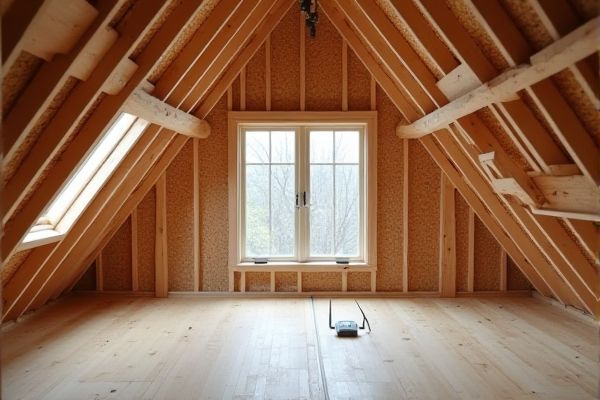
Placing your router in the attic can lead to weaker Wi-Fi signals due to interference and obstructions, whereas a central router location typically ensures more even coverage throughout your home. Discover how optimal router placement impacts your internet performance by reading the rest of the article.
Table of Comparison
| Aspect | Attic Router Placement | Central Router Placement |
|---|---|---|
| Wi-Fi Coverage | Limited to lower floors; signal may weaken through floors | Even, strong coverage across all floors and rooms |
| Signal Strength | Weaker in distant rooms; prone to interference | Stronger, direct signals throughout the house |
| Ease of Installation | Harder access; requires cables routed through walls | Easy access; central location simplifies wiring |
| Cooling & Ventilation | Attic heat may cause overheating issues | Better ventilation; prevents overheating |
| Security | Hard to physically secure | Easy to secure and monitor |
| Maintenance | Difficult due to location | Convenient for updates and troubleshooting |
Introduction to Router Placement: Attic vs Central Locations
Placing a router in the attic can extend Wi-Fi coverage to upper floors but may face signal degradation due to insulation and structural materials. Central router placement typically ensures more balanced signal distribution throughout the home by minimizing obstacles and promoting even coverage. Optimal router location depends on home layout, construction materials, and desired network reach.
Key Factors Affecting Wi-Fi Signal Strength
Placing your router in the attic can lead to weak Wi-Fi signal strength due to thick insulation, wooden beams, and metal ductwork obstructing signal transmission. A central router location, such as a central room or hallway, minimizes physical barriers and allows for more even signal distribution throughout your home. Key factors affecting signal strength include distance from the router, interference from building materials, and the presence of electronic devices causing signal disruption.
Pros and Cons of Attic Router Placement
Placing a router in the attic can improve signal coverage in multi-story homes by providing a higher vantage point for Wi-Fi distribution, potentially reducing interference from furniture and walls. However, attic placement often exposes the router to higher temperatures and dust, which can shorten device lifespan and lead to overheating issues. You may experience weaker signals on lower floors or in rooms far from the attic due to physical obstructions like ceilings and insulation materials that attenuate the wireless signal.
Advantages of Central Router Placement
Central router placement offers optimal Wi-Fi coverage by minimizing signal obstructions and reducing dead zones throughout the home. Placing the router centrally ensures balanced distribution of network strength, enhancing overall connectivity and speed for multiple devices. This strategic location supports better performance for streaming, gaming, and smart home devices compared to placing the router in an attic, where signals may be weakened by barriers.
Coverage Range: Attic vs Central Router Setup
Placing your router in the attic can reduce coverage range due to interference from ceiling materials and distance from main living areas. A central router setup typically provides more even coverage throughout the home by minimizing signal obstructions and optimizing signal distribution. For maximal Wi-Fi performance, a centrally located router ensures stronger connections across different rooms compared to an attic placement.
Signal Interference and Obstacles in Home Layouts
Placing a router in the attic often leads to increased signal interference and weakened performance due to physical obstacles like walls, floors, and insulation materials that obstruct Wi-Fi signals. In contrast, a central router location within the home minimizes barriers and optimizes signal distribution, reducing dead zones and improving connectivity reliability. Positioning your router centrally avoids common interference sources, enhancing overall network speed and stability.
Impact on Device Performance and Connectivity
Placing a router in the attic often leads to weaker signals and reduced device performance due to increased interference from insulation and structural barriers, which can significantly degrade connectivity. Central router placement optimizes signal distribution by minimizing physical obstructions and providing more consistent coverage across all rooms, enhancing overall device performance and reliability. Studies show that central placement reduces latency and packet loss, resulting in smoother streaming, faster downloads, and improved responsiveness for IoT devices.
Router Placement and Smart Home Integration
Placing your router in the attic can provide superior Wi-Fi coverage for multi-story homes but may experience signal degradation through floors and insulation, affecting smart home device connectivity. A centrally located router often ensures more consistent signal strength throughout living spaces, improving the reliability of smart home integrations such as smart thermostats, cameras, and voice assistants. Optimizing router placement involves balancing coverage needs with smart device locations to maximize network performance and responsiveness.
Energy Efficiency and Safety Considerations
Placing a router in the attic can lead to higher energy consumption due to increased heat exposure, which forces the device to work harder and reduces overall efficiency. Central router placement ensures more uniform signal distribution, minimizing the need for signal boosters and lowering power usage. From a safety standpoint, attic routers risk overheating and potential fire hazards, whereas central locations provide better ventilation and easier access for maintenance.
Best Practices for Optimal Home Wi-Fi Coverage
Placing a router centrally in the home facilitates even Wi-Fi coverage by minimizing signal obstructions and interference, ensuring stronger connectivity throughout multiple rooms. Attic router placement may cause signal attenuation due to insulation materials and structural barriers, resulting in dead zones and reduced speeds. Optimal home Wi-Fi coverage is achieved by positioning the router away from thick walls, metal objects, and electronic devices, enabling better line-of-sight for the wireless signals.
 homyna.com
homyna.com